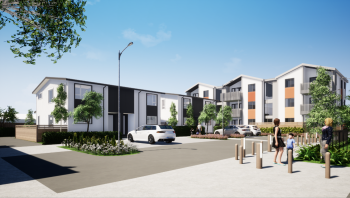New homes for Te Hapara consented
23 March 2022
New homes for 21 whānau will be built on adjoining sections on Gladstone Road and Mill Road in Te Hapara Gisborne. Kāinga Ora homes and communities have been granted resource consent to build one and two storey homes, and a 3 storey building on Gladstone Road.
Site works will start in the next month. This includes deconstructing one house and moving two others that will be relocated. Building is due to start from September this year.
This is great news for whānau desperate for a warm, dry suitable home, says Naomi Whitewood, (Ngāti Porou, Ngapuhi) Kāinga Ora Regional Director East North Island.
"There have been numerous heart-breaking stories in the media about whānau that have been living in motels or just have nowhere to live. They are exactly why Kāinga Ora is working at pace to build more social housing in Tairāwhiti."
With 549 whānau on the Social Housing Register in Tairāwhiti (as at September 2021), plus other whanau living in crowded or unsuitable housing, the need is great. There are just not enough houses available. These 21 high-quality and healthy homes will make a huge difference for whānau most affected by the housing crisis."
The homes to be built include 11 two-bedroom homes, 6 three-bedroom homes, 3 four-bedroom homes and a six-bedroom home.
"We expect the homes to be ready for whānau to move in by mid-2024."
The goal of Kāinga Ora is to build 170 new homes for Tairāwhiti whānau by 2024.
To achieve this we must make the best use of land we already own. The Gladstone Road/Mill Road site is a large piece of land, close to schools, shops and transport routes. It is an ideal position for many whānau. While the development will see more people living closer together than what we are used to in Gisborne, this is a model that has worked well around the world to build supportive communities."
Vicky is a Gizzy gal born and bred. She has worked for Housing New Zealand and now Kāinga Ora in Bay of Plenty and Gisborne for over 30 years.
"I was recruited straight from Gisborne Girls High. Cadet number 5 – that’s me, the last cadet recruited in Gisborne. I have had many roles in the organisation including managing Whakatane and Rotorua offices. I am a grass roots person who values the rapport I have with people who live in our homes. I understand the Gisborne culture and what our people need. When I heard that we were going build a three-storey building to house our customers I was not supportive. I have since travelled to other districts to see how the multi-storey developments work."

Render of the new development
"I am now convinced they are a game changer and will be perfect for many of our whānau," Vicky enthuses.
"There is an opportunity to build a community around the homes with a playground and common spaces. This is important for many of our whānau. The homes have small or no grounds. Not everyone wants to mow lawns, or look after gardens. A more compact lifestyle means less to do and therefore more time to enjoy other things in life. It’s time now to learn off our urban cousins."
Vicky is now a Placement Advisor at Kāinga Ora. It will be her team that matches these new homes to people with the highest priority for a home of that size and in that location.
"We will also give consideration to whānau who have an existing connection to the Te Hapara community and who will be a good fit with the neighbours. These homes are just across the road from Te Hapara School so that will be an important consideration."
"When whānau move we always help them to settle in to their new home and community. Part of that is making sure they understand their responsibilities. That includes being good neighbours and connecting with their communities."
In 2020 and 2021 we asked for feedback from the Te Hapara community on proposed concept designs for this development, Naomi said. “We received a range of views about the proposed development; all of which has been considered.”
"While there was support for the development, concerns about the height of the three storey building and the density of the housing was the most common feedback."
"The feedback helped us refine our designs both to ensure we meet the pressing need for more housing in Gisborne, while building homes which fit in with the neighbourhood. Our plans changed to provide 21, (instead of 22) homes. Other changes that have been made include installing solid timber acoustic fencing to help reduce noise, using privacy screens on the eastern balconies of the three-storey building and designing site specific planting to screen neighbours and residents."
"Our thanks to all those that contributed to the consultation process."
Media Contact
Page updated: 23 March 2022
